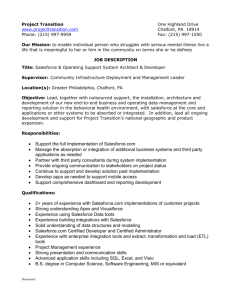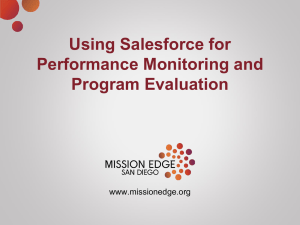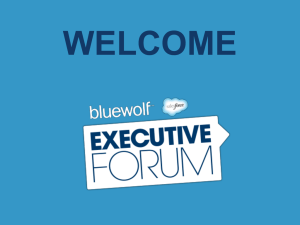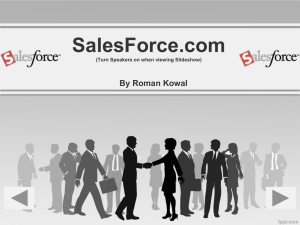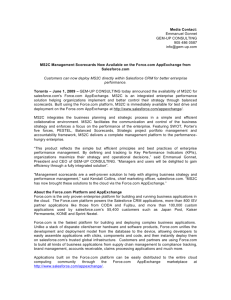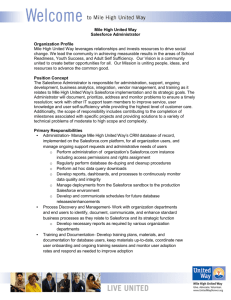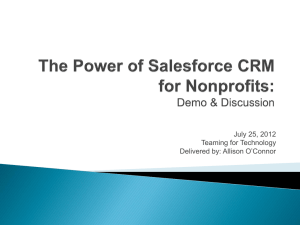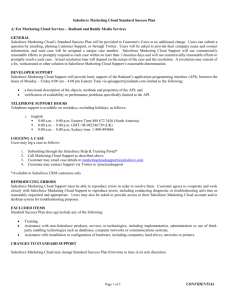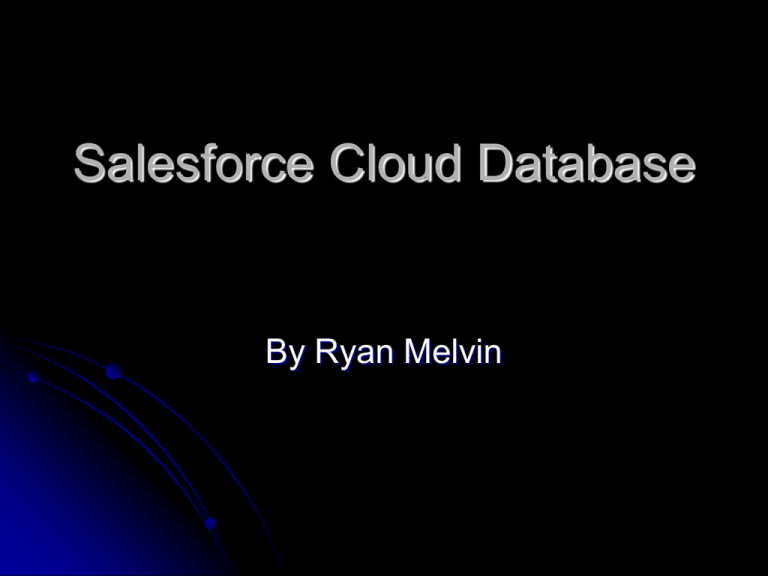
Salesforce Cloud Database
By Ryan Melvin
Outline
Introduction
Advantages of Cloud Computing
Major Techniques
System Architecture
System Design
Implementation
What I learned
Demo
Introduction
What is Salesforce?
- Salesforce is a cloud-computing infrastructure
that enables businesses and users to use
software and applications over the internet
- Rather than running software and applications
on local machines, everything is accessed over
the internet through the Cloud-based vendor’s
website (e.g., salesforce.com)
- With cloud computing, computing is delivered
as a service rather than as a product.
Advantages of Cloud
Computing
Software does not have to be installed and
maintained
All upgrades are automatic
Servers are not needed
Manual Backups are not needed
Software and hardware is maintained by the
Cloud-based vendor (e.g., Salesforce.com)
You only pay for the resources you use
Major Techniques
Transaction Support:
Transaction support is built into Salesforce, so it
does not need to be implemented by the DBA;
changes to the database are only committed
when the the apex code in the controller and on
the visualforce page have finished executing.
Either all of the changes are made or no
changes are made to the database.
Salesforce also provides constructs for manually
creating savepoints, and manually rolling back
the state of the database to its state at the time
the savepoint is created
Savepoint sp = Database.setSavepoint();
Database.rollback(sp);
Security
-
Salesforce provides extensive security
measures
Every user on Salesforce belongs to a certain
profile (regular user, staff member, etc)
-
-
Permissions are controlled by setting access
rights for each profile (what tables can be
read/modified, etc)
Permissions for Staff members
Rather than creating views to restrict access to
fields, access to fields can be directly set for
each profile
Field Access
System Architecture
Salesforce uses the MVC(Model-ViewController) architecture
Database tables are models
Visualforce pages are the user interface and
view
Apex classes are the controllers
The controller is the “middle-man” between the
model (database) and view (Visualforce page)
The controller (an Apex class) receives user
input submitted from the view (Visualforce
page), which invokes actions on the model
(database) (e.g. retrieve records)
After the controller retrieves the data from the
model (database), it then communicates the
data with the view, where it is displayed
System Design
Three levels of users: users, staff, and
management
Users can:
Buy products from the storefront website
Leave feedback
Request an account by filling out the registration
form (A staff member must create the account
for them)
Staff can:
Process customer orders
Add/edit/remove merchandise (e.g., change
quantity, etc)
View all staff information except salary
View all departments
View customer feedback
Process requests for accounts from users
Act as users and purchase products from the
storefront
Management can:
Add/edit/remove staff members (e.g. hire/fire)
Add/edit/remove departments
View all staff information (including salary)
Do everything staff and users can do
Tables for Staff management:
Staff(fields: Staff ID (PK), first name, last name,
department ID (FK), age, sex, DOB, position,
salary)
Department(Fields: department ID (PK),
department name, department phone number)
Tables for Warehouse:
Merchandise(fields: Merchandise Name(PK),
Description, Price, Total Inventory)
Invoice Statement(fields: invoice number(PK),
status, invoice value)
Line Item(fields: item number (PK), Invoice
Statement (PK, FK), Merchandise (FK), Unit
Price, Units Sold, Value)
Tables for User Management:
PaymentInformation (fields: email(PK), first
name, last name, telephone number, billing
address, shipping address, credit card number,
City, State, Zip Code, Country)
Feedback(fields: email(PK), comments(PK),
Date)
Registrationrequest(fields: email(PK), First
Name, Last Name, Community Nickname)
Implementation
Example: The model, view, and controller
for displaying the merchandise on the
storefront page
The Model
The Controller
The Model
The View
What I learned
How to create database tables, Apex classes
(controllers), and Visualforce pages
More about the MVC model and how it is applied
on the Salesforce Cloud
How to create profiles (user groups)
How to set permission rights and field access on
Salesforce
What I learned (Cont’d)
How to read/insert/update/delete database
records using tabs within applications
Some of the Apex programming language
How to build a storefront on the Salesforce cloud
The benefits of using a cloud database
Demo
Creating a Table and a Field
Adding a new merchandise product
Making A Purchase on the
Storefront

